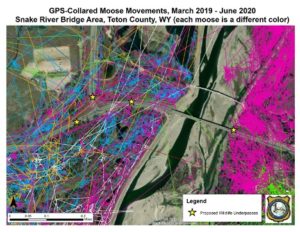By Renee Seidler
This month, the Teton County Board of Commissioners unanimously approved the Agreement to Render Services (ARS) that allows Wyoming Department of Transportation (WYDOT) to conduct the planning, engineering, design, permitting and construction of two wildlife crossing structures near the intersection of WY-22 and WY-390. These structures will be funded by Teton County using Special Purpose Excise Tax (SPET) money, which was supported by 79% of voters in November 2019. These two crossing structures are part of a larger project that will protect wildlife and motorists alike from collisions at this busy intersection. Because of this ARS, the County and WYDOT can continue to move forward together on their collaborative project to protect wildlife in and around this busy intersection.

Map showing Wyoming Game and Fish (WGFD) GPS-collared moose movements in the Snake River Bridge Area. Yellow stars indicated future wildlife underpass locations.
As the Environmental Assessment for the Tribal Trails Connector moves forward, Jackson Hole Wildlife Foundation is working closely with our agency partners to provide expertise and data to help inform the decision-making process. You can listen to the Board of County Commissioners most recent workshop on Tribal Trails here. The discussion starts at the 46:45-minute mark. Most of the conversation speaks to design ideas for the Coyote Canyon/Indian Springs intersections, but commissioners also touched on topics of wildlife crossings to mitigate wildlife-vehicle collision and wildlife permeability issues on WY-22. To stay abreast of this topic, link to the project website.
I am lucky to be a part of the Jackson Hole Wildlife Foundation team that has played such a vital role in providing and interpreting roadkill data for the county, state, and other partners. Amongst our many other accomplishments, we have been an active member of the Wildlife Stakeholder Group that informs wildlife crossings projects for the county and state; we have helped inspire the community to support building wildlife crossing structures through approval of the Special Purpose Excise Tax; and we have provided input on location and design of wildlife crossing structures. I am continuing this legacy of working closely with our partners, both NGOs and agencies, and I have been welcomed into the conversations as an expert in road ecology. I look forward to growing these relationships and adding to the healthy discussions concerning the conservation of wildlife in Jackson Hole.
My best to you,
Renee Seidler
Executive Director JHWF
